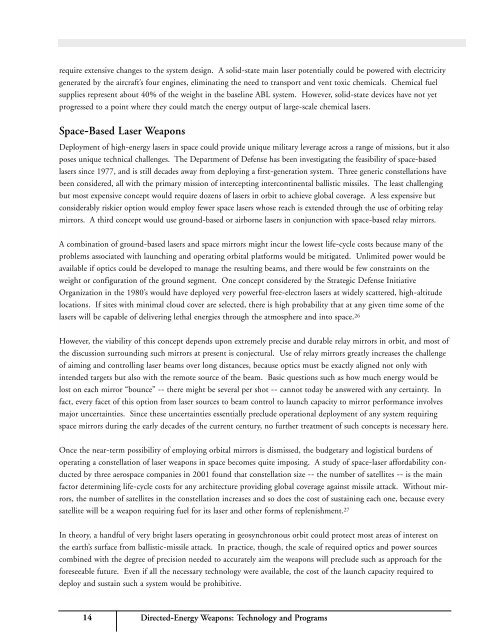directed-energy-weapons
directed-energy-weapons
directed-energy-weapons
Create successful ePaper yourself
Turn your PDF publications into a flip-book with our unique Google optimized e-Paper software.
equire extensive changes to the system design. A solid-state main laser potentially could be powered with electricitygenerated by the aircraft’s four engines, eliminating the need to transport and vent toxic chemicals. Chemical fuelsupplies represent about 40% of the weight in the baseline ABL system. However, solid-state devices have not yetprogressed to a point where they could match the <strong>energy</strong> output of large-scale chemical lasers.Space-Based Laser WeaponsDeployment of high-<strong>energy</strong> lasers in space could provide unique military leverage across a range of missions, but it alsoposes unique technical challenges. The Department of Defense has been investigating the feasibility of space-basedlasers since 1977, and is still decades away from deploying a first-generation system. Three generic constellations havebeen considered, all with the primary mission of intercepting intercontinental ballistic missiles. The least challengingbut most expensive concept would require dozens of lasers in orbit to achieve global coverage. A less expensive butconsiderably riskier option would employ fewer space lasers whose reach is extended through the use of orbiting relaymirrors. A third concept would use ground-based or airborne lasers in conjunction with space-based relay mirrors.A combination of ground-based lasers and space mirrors might incur the lowest life-cycle costs because many of theproblems associated with launching and operating orbital platforms would be mitigated. Unlimited power would beavailable if optics could be developed to manage the resulting beams, and there would be few constraints on theweight or configuration of the ground segment. One concept considered by the Strategic Defense InitiativeOrganization in the 1980’s would have deployed very powerful free-electron lasers at widely scattered, high-altitudelocations. If sites with minimal cloud cover are selected, there is high probability that at any given time some of thelasers will be capable of delivering lethal energies through the atmosphere and into space. 26However, the viability of this concept depends upon extremely precise and durable relay mirrors in orbit, and most ofthe discussion surrounding such mirrors at present is conjectural. Use of relay mirrors greatly increases the challengeof aiming and controlling laser beams over long distances, because optics must be exactly aligned not only withintended targets but also with the remote source of the beam. Basic questions such as how much <strong>energy</strong> would belost on each mirror “bounce” -- there might be several per shot -- cannot today be answered with any certainty. Infact, every facet of this option from laser sources to beam control to launch capacity to mirror performance involvesmajor uncertainties. Since these uncertainties essentially preclude operational deployment of any system requiringspace mirrors during the early decades of the current century, no further treatment of such concepts is necessary here.Once the near-term possibility of employing orbital mirrors is dismissed, the budgetary and logistical burdens ofoperating a constellation of laser <strong>weapons</strong> in space becomes quite imposing. A study of space-laser affordability conductedby three aerospace companies in 2001 found that constellation size -- the number of satellites -- is the mainfactor determining life-cycle costs for any architecture providing global coverage against missile attack. Without mirrors,the number of satellites in the constellation increases and so does the cost of sustaining each one, because everysatellite will be a weapon requiring fuel for its laser and other forms of replenishment. 27In theory, a handful of very bright lasers operating in geosynchronous orbit could protect most areas of interest onthe earth’s surface from ballistic-missile attack. In practice, though, the scale of required optics and power sourcescombined with the degree of precision needed to accurately aim the <strong>weapons</strong> will preclude such as approach for theforeseeable future. Even if all the necessary technology were available, the cost of the launch capacity required todeploy and sustain such a system would be prohibitive.14 Directed-Energy Weapons: Technology and Programs


